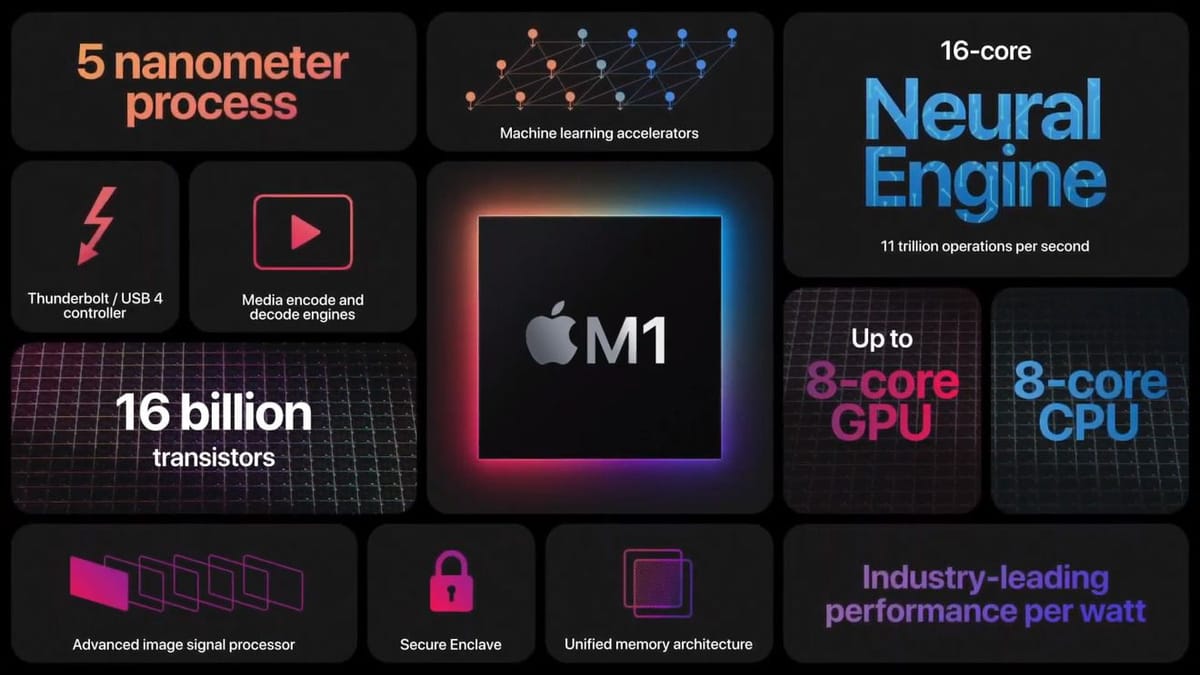Apple Launches In-House Produced M1 Chip
The M1 could be Apple’s most valuable computer innovation and could mean that the company reduces its outsourcing dependencies and costs while improving its product offerings.

Apple launched the new and in-house produced M1 chip for its MacBooks and Mac Computers. The M1 Chip was launched alongside MacBook Air, a 13-inch MacBook Pro, and a new Mac Mini, a mini version of their Mac computers (all pictured above). The Mac Mini is a smaller version of their Mac Pro Tower and is a flat mini version. Apple has outdone itself this year with product launches despite the COVID-19 pandemic. The company has conducted numerous launches and has offered its customers a whole lineup of products this year.
Apple's Shift Away from Intel Chips to In-House Produced ARM Chips
The M1 chip is a shift from Intel chips and is an in-house produced ARM chip by Apple. The chip was specifically made for MacBooks and Macs and is a tougher version of iPhone chips such as the A14 Bionic. Apple takes pride in creating a custom chip for their computers and is an industry leader in innovation and technology.
What Apple's Shift Means for Intel
Apple’s launch forces Intel back to the drawing board and will push Intel to become more innovative to retain a competitive advantage. Intel chips have their own framework and configuration meaning that Apple has had to create compatibility between the M1 chip and applications and software running on Intel chips. The chip uses ARM architecture which is a family of RISC or reduced instruction set computing.
Apple: M1 Chip Faster, Smarter, and Consumes Less Power
Apple has claimed that the M1 chip is faster, smarter, and consumes less power and battery life. Therefore, the company said that the M1 chip would revolutionize how customers interact with their Macs and MacBooks and would mean crispier image and video processing, snappier applications, and longer-lasting battery life.
Apple doesn’t have extensive experience in the field of computer chip production but is expected to have made a commendable effort at seeing through its in-house chip production. The company has enough resources, skills, and manpower, however, to see it change the way computing happens.
16 Billion Transistors in the M1 Chip
According to Apple, the M1 is packed with 16 billion transistors and uses the 5-nanometer process technology. Essentially, this means that the chip encapsulates memory, security, input and output, and the processor in one chip; a shift from requiring several chips to ensure all these features.
The M1 combines these technologies in what the company calls an SoC or a single system on a chip. The M1 is, therefore, able to deliver increased efficiency, simplicity, higher-level and seamless integration, and incredible performance.
Unified Memory Architecture, UMA
The company also announced that the chip would feature a unified memory architecture or UMA. UMA unifies M1’s low-latency memory and high bandwidth into a single pool of memory removing the need to replicate numerous pools of memory when accessing the same data.
Consequently, the M1 increases power efficiency and improves performance. The company says that the chip has over seven times faster image processing and nearly four times faster video processing.
In terms of M1’s power usage, the company says that it uses one-quarter of the power that the latest computer chip would use at peak performance.
Four Efficiency Cores in the M1 Chip
For lighter workloads, the M1 uses four efficiency cores that use one-tenth of the power while still delivering a stellar performance. These efficiency cores, or e-cores, ensure that lighter workloads do not get to performance cores, which can then be used for heavier workloads. Apple also says that the chip has over three times more CPU performance per watt. Essentially, the chip will deliver more than two times the power of a PC using just 10 watts.
Additionally, the chip can match the peak performance of a PC chip while using just a quarter of the power. The chip uses an 8-core GPU, or graphics processing unit, with the capability of handling over 25,000 concurrent threads. The chip boasts two times faster GPU performance and matches the peak performance of a PC using just a third of the power. The chip also boasts improvements in machine learning, security, and increased web surfing and video playback periods.
Is the M1 the Most Valuable Apple Innovation Yet?
The M1 could be Apple’s most valuable computer innovation and could mean that the company reduces its outsourcing dependencies and costs while improving its product offerings. Apple will be in a position to avert any outsourcing costs and dependencies while investing in capacity and its capabilities.
Apple's Product Differentiation via an In-House Chip
The M1 chip also ensures that Apple differentiates itself from other computer makers and maintains its exclusivity while gaining a competitive advantage. The PC space is very competitive and a lot of PC manufacturers rely on Intel and its chips.
M1: A Competitive Edge for Apple, INC.
Apple will, therefore, gain a competitive advantage by making its own chips in-house and creating an entirely new ecosystem of applications and software. Software and app manufacturers will need to create apps that will work with the M1 and macOS Big Sur operating system, under ‘Universal apps’. Universal apps will see apps created that can work both on intel-based chips and the M1 chip. Big Sur comes with numerous improvements in the new MacBooks and Mac Mini, as did iOS 14, and the recently released iOS 14.2.





